- Home
- Injections
- Laser Treatments
- Specialties
Specialtiesview all
- Other Treatments
- Before After Photos
Before After Photosview all
- Contact Us
- Doctor And Staff
- About Celibre
- Blogs
We live in a fast paced world. Information is at our fingertips in an instant and we do more in a day now than previous generations did in a week’s time. Sounds like progress, right? Well, when it comes to the practice of medicine, not so much. Unfortunately, medical providers are too pressed for time to sit down and talk to their patients much anymore. We’re not saying every practitioner is like this, but many are. And while they may be able to “see” more patients in a day, sometimes patient education gets lost in the process.
Take our patient “Mary” for example. She came to us after seeing two different dermatologists over a two year period. One had diagnosed her with acne and the other with acne rosacea. Poor Mary was not only very confused about what her problem was; she had spent a considerable amount of both time and money on several different topical and oral medications. None of it had helped her much—in fact, by the time she made it to our office, her skin was red, dry and painful.
We took the time to sit down with Mary, ask her detailed questions about her skin and her breakouts. We physically looked at the skincare products she was using every day and made a detailed note of how each was used and what is seemed to do to her skin. Together, we devised a new, milder and gentler skincare routine and we started her on laser treatments for her skin.
Within two weeks, her skin was very much improved! By looking at her photos above, you can see what a difference our approach made for her. But we can’t take all the credit. Mary listened to our advice and was regimented about diligent, gentle skincare at home. We credit her with making the biggest difference in her skin!
All we did was take the time to listen and talk with her. This is what we love to do! We believe that making you a part of the treatment team is the best way to achieve successful skin care. Unfortunately, in our fast paced world today, this is the exception and not the norm in a medical office. Celibre Medical believes that patient education is the cornerstone of what we do. Forget the fancy lasers and expensive treatments—an educated patient will see the best results each and every time because they understand the why and how of what we ask them to do at home and what we do here in the office.
If you’d like to experience a different approach to skincare, we’d love to get started on the journey with you. You value your time and money and we will do the same. Together, we can help you achieve your skincare goals.
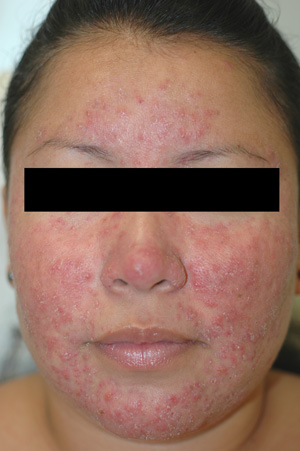
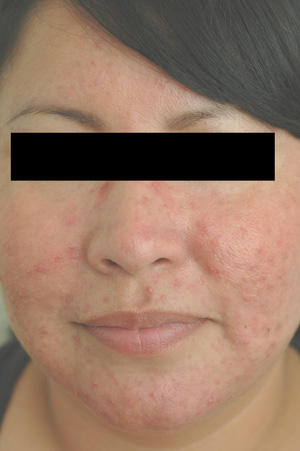
* Rosacea Before and After Pictures
If you have embarrassing stretch marks on your tummy from a sudden weight gain or after pregnancy, then you’ve probably asked yourself this question. But you might be surprised to learn that not everyone is a candidate for a tummy tuck. Even when a tummy tuck is an option, it may not completely remove your stretch marks.
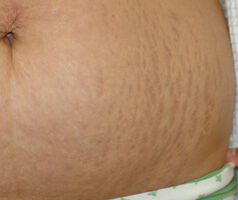
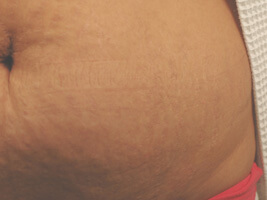 A surgical tummy tuck requires that you have enough excess skin and tissue in the abdomen area for it to be removed surgically. Some women just don’t have enough of this “excess” to take off, but they still have tummy stretch marks that they want treated. If this sounds like you, then you may be better off with laser stretch mark removal.
A surgical tummy tuck requires that you have enough excess skin and tissue in the abdomen area for it to be removed surgically. Some women just don’t have enough of this “excess” to take off, but they still have tummy stretch marks that they want treated. If this sounds like you, then you may be better off with laser stretch mark removal.
If you do have enough skin and excess tissue for a tummy tuck, the surgery may not completely remove all the skin that has stretch marks on it. A tummy tuck removes skin/tissue from the lower abdomen and then pulls the skin around the belly button downward. If your stretch are above the level of your belly button, they will likely remain visible after surgery. This is very important to consider if you thought your surgery would just “take care of everything”. It isn’t always the case!
If you just don’t want to have surgery or can’t for various reasons, then your only option is laser treatment. And some patients benefit from both a surgical approach followed by laser treatment. There is no one-size-fits-all plan for everyone!
We think it’s important to consider all the possible scenarios for stretch mark removal. Both surgery and laser treatments may be options to consider for you.
We’ve all had a bad bruise at one time or another. You know the kind. Deep, dark purple that fades to varying shades of blue, green and yellow (slowly) over a period of weeks until it’s gone. If you’ve had a deep bruise that left a brown spot after it resolved, you may be dealing with a case of hemosiderin staining.
Hemosiderin staining doesn’t happen to everyone after a bruise, but if you have a medium skin type (Asian, Hispanic or light African-American) or if you’ve had sclerotherapy injections for spider veins or dermal filler injections you may be at a higher risk of developing this problem. Basically, it happens when some of the components of your red blood cells are trapped in the skin as a bruise resolves. This results in a “stained” or dark appearance of the area which can last a very long time without treatment.
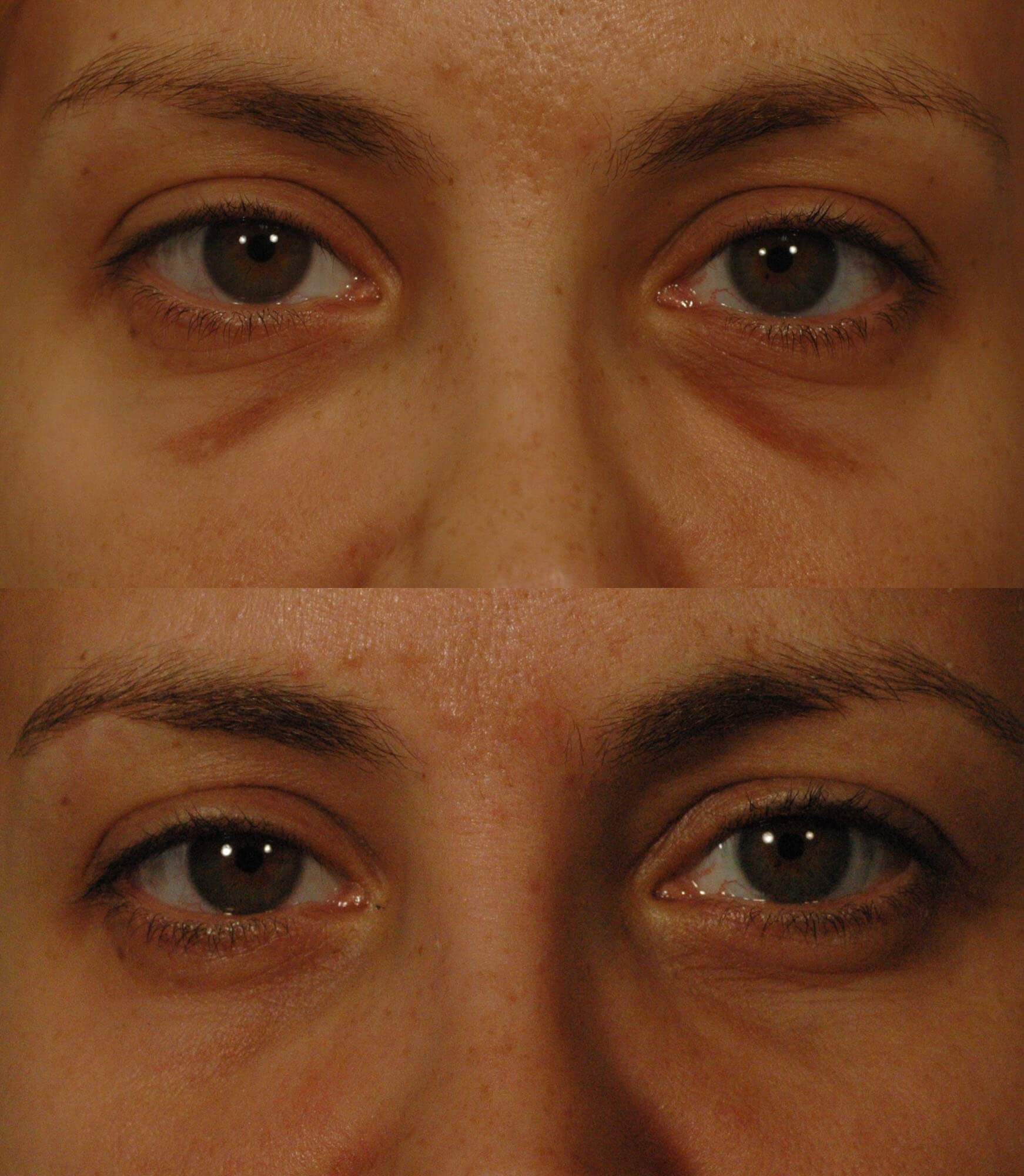
Here are photos below of a patient who came to us for help after she’d had filler injections beneath her eyes. She’d had bruising immediately after her treatment that just hadn’t gone away over a long period of time. To make matters worse for her, she couldn’t find anyone in the Los Angeles area that would help her!
With just a couple of gentle q-switched Nd:Yag laser treatments, we were able to remove her hemosiderin staining. She was extremely grateful and we were very happy that we could help her.
Don’t suffer with this tough problem any longer! If you think that you have hemosiderin staining from a previous procedure or injury, please give us a call and come see us for an evaluation. We have effective, proven laser solutions that are safe for every skin type.
Stretch marks represent a significant cosmetic concern for many patients – male and female alike. Typically, stretch marks result in redness (stretch marks in Caucasians) or brown/darker pigmentation (stretch marks in darker skin types) as well as texture changes. Many times, the body will fade the color (both red or brown) over time – provided that the areas are well protected with sun screen when exposed to the sun. It is generally accepted that whatever pigment remains six months after the stretch marks appeared may be permanent. At this time, the body’s healing response is mostly complete and residual pigment may not fade on it’s own. In addition, any texture changes associated with the stretch marks gets harder to revise as time passes.
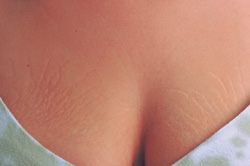
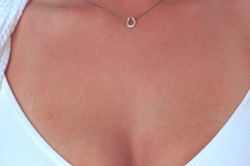 Although medical lasers offer an excellent option to resolve the color changes associated with stretch marks – current research now supports improved outcomes when intervening earlier rather than later. For example, stretch marks that are red in color are related to an increase in vascularity (blood flow) resulting from the trauma to the skin caused by the stretch marks. By resolving the vascularity early on with lasers, there is less inflammation and a better healing response. This allows for improved collagen reformation and textural improvement.
Although medical lasers offer an excellent option to resolve the color changes associated with stretch marks – current research now supports improved outcomes when intervening earlier rather than later. For example, stretch marks that are red in color are related to an increase in vascularity (blood flow) resulting from the trauma to the skin caused by the stretch marks. By resolving the vascularity early on with lasers, there is less inflammation and a better healing response. This allows for improved collagen reformation and textural improvement.
Regardless of which color the stretch marks are (red or brown) and whether or not they are textured or flat, we have found that early intervention for stretch marks optimizes the healing process leading to less noticeable stretch marks in the future.
Celibre Medical Torrance Stretch Mark Removal program, celibre.com/stretch. Schedule a free consultation for Laser Stretch Mark removal Torrance at celibre.com/contact-list.
Laser stretch mark removal treatments in Torrance by Celibre Medical. More Celibre Medical Torrance Stretch Mark removal pictures at celibre.com/stretch.
Lori Ishii Haney, RN, MEP-C
Certified Medical Laser Safety Officer
Laser resurfacing with Fraxel has gotten a lot of media buzz in the past (2006 – 2008). So, it’s very natural that patients who come to us ask if we offer it. The answer is that we don’t. The question that follows is usually, “Why not?” The reason that we don’t offer Fraxel to our patients is because we don’t believe that it can do a better job than the technology that we currently use for fractional laser resurfacing which is the erbium. We won’t say that Fraxel doesn’t work or that it’s not a good choice. We are simply saying that in our experience and through feedback we’ve gotten from patients who’ve had it, we feel that what we currently offer is safer and better.
First, let’s understand that Fraxel is a “fractionated” laser resurfacing treatment. This means that during the treatment, a portion or “fraction” of the top layer of skin (the epidermis) is removed. For our fractionate laser resurfacing, we use the Sciton profractional.
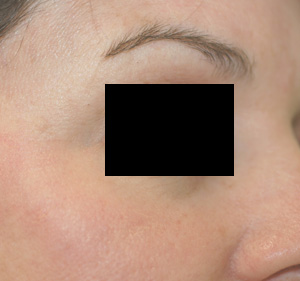
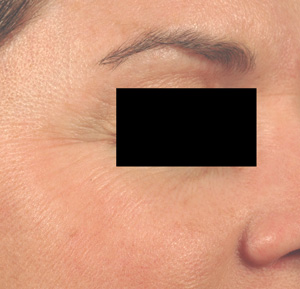
If you take a look at Realself.com, there’s a good-sized group of people who’ve had Fraxel who weren’t exactly thrilled with their results. In some circles, it only got about a 52% approval rating. On the other hand, we’ve found our patient’s satisfaction rate with fractional erbium laser resurfacing (Sciton Profractional) is at or above 80%.
With lasers, newer doesn’t always mean better. When we’re are asked about why we don’t offer technologies like Fraxel, Pearl or fractionated CO2 with plasma or erbium, we always point back to the fact that for our practice, fractional erbium laser resurfacing is a tried and true technology that is versatile and familiar in our hands. We have over 15 years of experience with it, and we know it in and out. We’ve seen what it can and can’t do and we feel it’s the best available technology for the patients who come to our office for improvement of wrinkles and acne scars. Our goal is to be the best at what we do…even if that means not having every type of technology that’s out there. At Celibre Medical, you will not find the “jack of all trades, master of none” mentality. Patients like you come to us because we are the laser experts and we provide superior value by offering the most effective and safest treatments available.
We’ve found over the years that the wavelength of erbium (2940) is ideal for resurfacing because it penetrates into the dermis with little risk of hypo-pigmentation for darker skin types.
There are many newer devices that get a lot of media attention for being “FDA-approved” for skin rejuvenation. While FDA-approval is important, mainly because it ensures the device is safe, it doesn’t always mean it will be effective. This is where hands-on experience comes into play. Being able to see how a device works on a variety of different skin types (colors) for a variety of different problems is really proof of efficacy. We believe this is why Celibre Medical should be your first and only choice for laser skincare. We don’t offer any and all treatments out there, but we do offer time-tested, safe and patient-approved ones that can help you achieve a better, younger looking you!
Sun spots go by a variety of different names. Age spots and liver spots are two other common terms used for these pesky, brown spots. But, the proper medical term for them is “solar lentigines”. If you’re confused about what causes them, we don’t blame you! Is it sun, age or a liver problem? The answer is simple: if you have sun spots, age or liver spots, then you got them from spending time out in the sun.

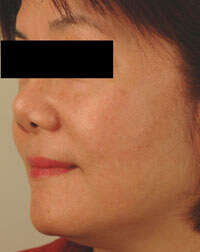
Even if you’ve never been a sunbather, the constant, regular sun exposure we get in Southern California can make your face and the backs of your hands a likely place for them to show up. So, why do age spots tend to show up later in life? It’s a good question. The answer is that as our skin ages, it thins quite a bit. This allows many of our skin’s deeper structures to become more visible on the surface. This includes things like blood vessels and brown spots. Rather than being buried deep in the skin, the pigmentation associated with sun spots is in the very outer layer of skin, the epidermis. They are also completely benign (non-cancerous).
If you don’t like your age spots and want them removed, you’re in luck! Class IV medical lasers are an excellent and safe treatment option to get rid of them. These lasers can be used anywhere on the body. Treatment is fairly quick and there is no downtime. However, if you decide to pursue laser treatment of your sun spots, then we will strongly urge you to wear a broad-spectrum sunscreen each and every day as this will help keep your skin looking clear and prevent more pesky sunspots from popping up down the road.
“What?” you’re probably asking as you read our title. “How can adding more of something help my bags look better? Shouldn’t you take something out rather than add it to an area that’s already puffy?” We know, it seems counter-intuitive, but trust us—it works!
There are a few different reasons why people develop under eye bags or hollow “tear troughs”. The end result for most people though is the same regardless of why their under eye area isn’t smooth: they look tired and older than they should.
Filler can and does help with these problems. Regardless of why they happen, dermal fillers like Restylane “bridge the gap” between an under-eye bag and your cheek. It can also fill a deep crease or tear trough which makes the lower eyelid look smoother and more youthful. Think of filler as a bit of a “camouflage” that helps hide some of the structural changes that happen in the under eye area with age. Because this area of the face moves very little and the filler is placed very deep, the results can last for quite a while (usually 6-12 months)!
Still not convinced? Just take a look through our before and after photo gallery to see some examples of patients with different under eye concerns who saw improvement from injections of dermal filler in this area.
If you’re concerned about the sensitivity of this area, you should be! It takes an extremely skilled and knowledgeable injector with plenty of experience to get these delicate injections just right. However, when done correctly, the results are truly amazing and there if usually very little pain, bruising or swelling afterwards.
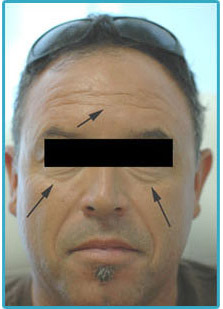
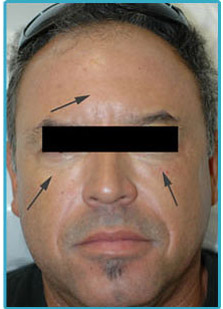
Restylane for Loose Skin Under the Eyes Photo
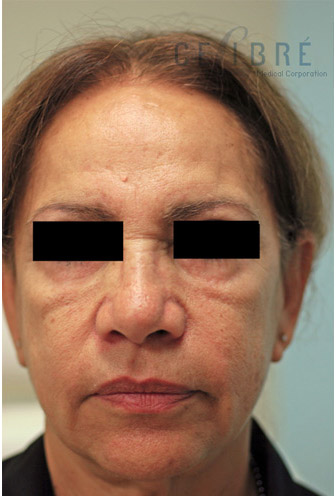
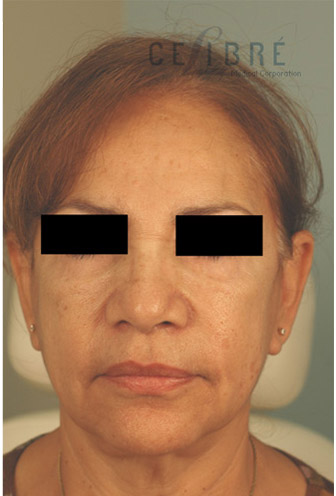
Restylane for Dark Circles Photo – Age related
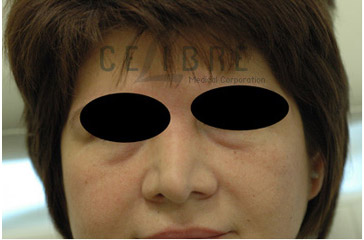
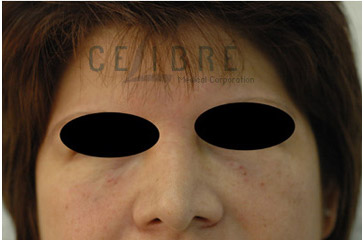
Restylane for Dark Circles Photo – Genetic
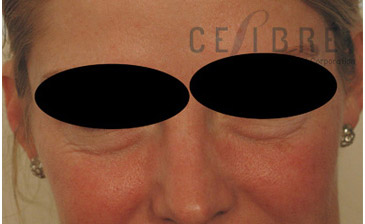
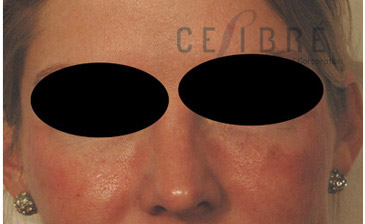
Puffiness and Wrinkles Under the Eyes Photo
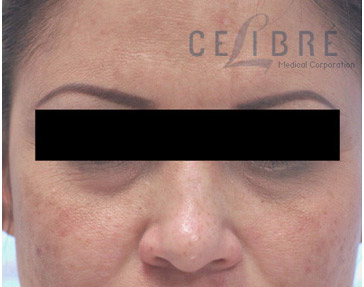
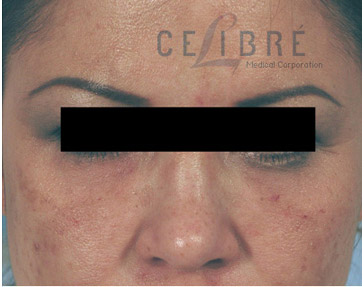
Dark Circles and Eye Bags Hispanic Patient Photo
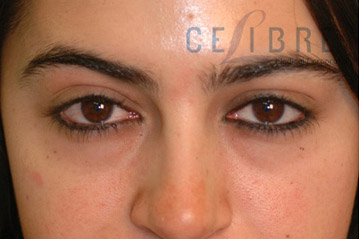
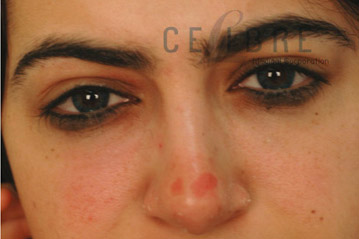
Young Patient for Dark Circles Under the Eyes Photo
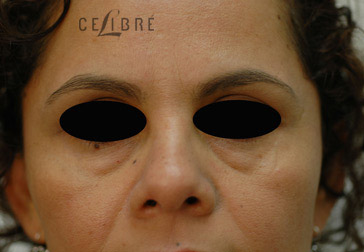
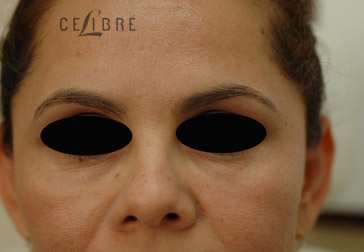
Eye bags Before and After Restylane Injections Photo
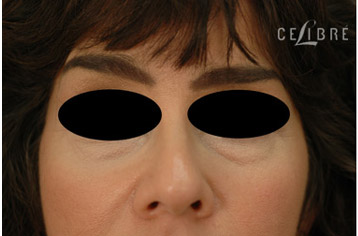
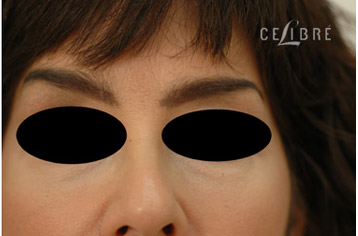
Eye bags Caucasian Before and After Photo
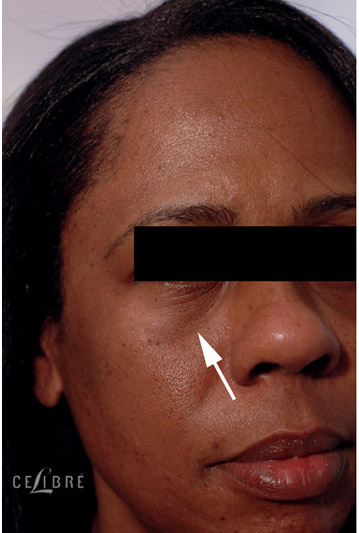
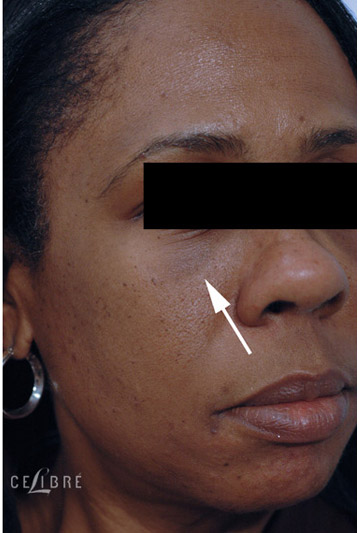
Dark Circles Under Eyes Black Skin After Restylane Photo
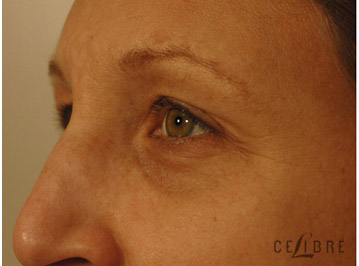
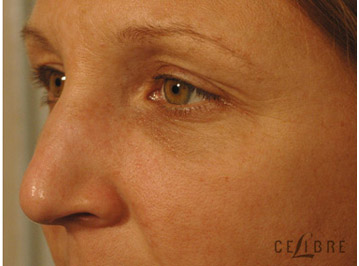
Under Eye Hollows Before and After Juvederm Photo
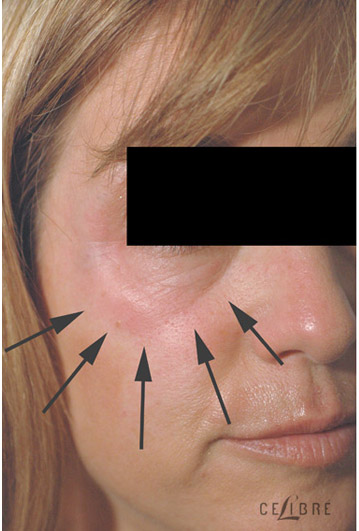
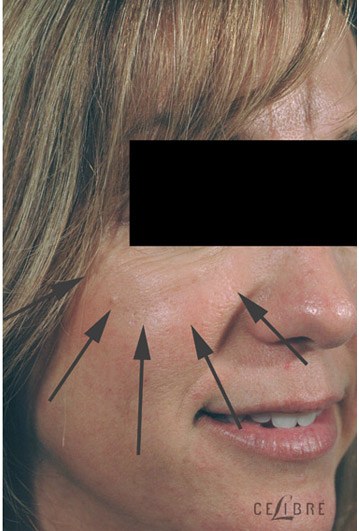
Hollows Under the Eyes After Restylane Photo
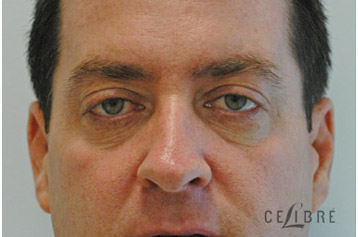
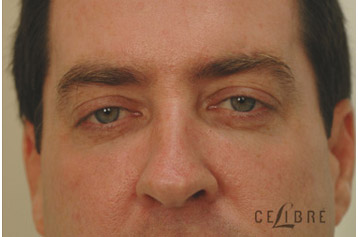
Tired Under Eyes and Wrinkles Before and After Restylane Photo
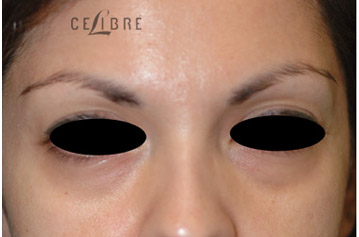
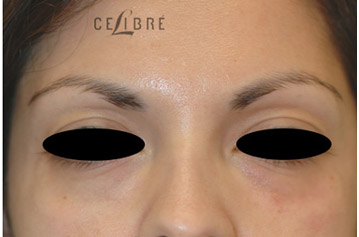
Darkening Under the Eyes Young Ethnic Patient Before Juvederm Photo
Having melasma is difficult. Many like you tell us that it negatively impacts their emotional and mental health. Many feel frustrated, disappointed and depressed by it. We truly feel for our melasma patients. If you’re fighting this tough skin problem, we understand. And yes, you want to know why you have melasma and what causes it? Unfortunately, we don’t fully understand why you get it. But we can tell you that it isn’t due to anything that you did or didn’t do to your skin.
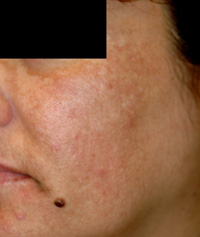
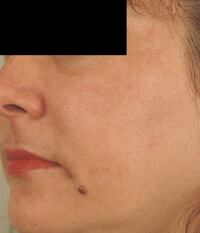 While this answer may relieve you from feeling responsible for your melasma it also can make you even more frustrated not knowing! But you are not powerless. While there is no cure for melasma, it is controllable. Here’s what we know about Melasma:
While this answer may relieve you from feeling responsible for your melasma it also can make you even more frustrated not knowing! But you are not powerless. While there is no cure for melasma, it is controllable. Here’s what we know about Melasma:
It is important to reiterate that although it’s not curable, melasma can be effectively controlled. Sometimes, eliminating a stimulating factor such as sun exposure or stopping the pill can make a huge difference on how your melasma responds to pigment-fading treatments.
Your biggest key to successful treatment of Melasma is understanding your condition and working with a knowledgeable provider who can help you determine the treatments that would benefit you most.
We get asked this question all the time and there is no one single answer. One of the follow up questions we ask is “Which wrinkles?” Is it the crow’s feet on the sides of the eyes that wrinkle up during the smile? Is it the frown lines between the eyes that appear when frowning or is it fine lines and/or loose skin below the eyes. We have options for all of these, but they vary depending on the area.
Frown Lines:
Your best bet for frown lines is always going to be Dysport or Botox. Botulinum Toxin Type A relaxes the muscles that cause the frown lines. The area smooths out nicely for 3-4 months after a proper dosage, leaving you looking very relaxed. In rare instances where the frown lines are very deep, we will use a small amount of Hyaluronic acid based filler such as Restylane to improve the area. We do not recommend laser resurfacing in this area because it does not generally help. See photos below.
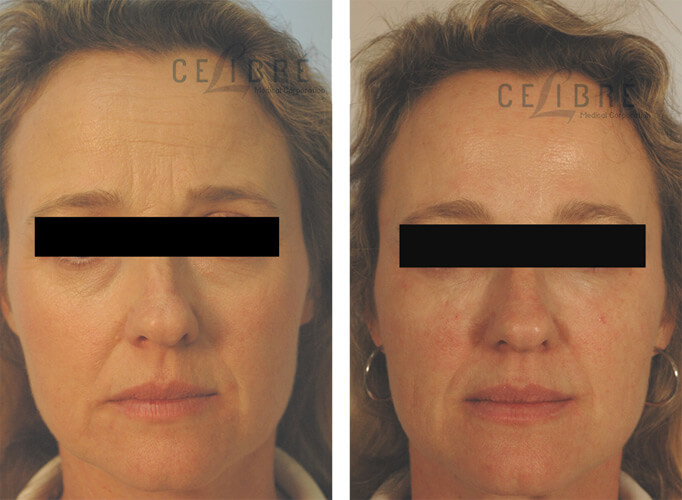
Crow’s Feet (smile lines):
For the crow’s feet lines on the sides of the eyes, Dysport or Botox are also our go to treatments. Laser resurfacing has more benefit in this area than between the eyes, but the fundamental cause of the wrinkles, (muscle contraction) is not changed by laser resurfacing so the improvement from resurfacing is usually mild. We love Dysport and the duration would be in the same 3-4 month range. See photos below.
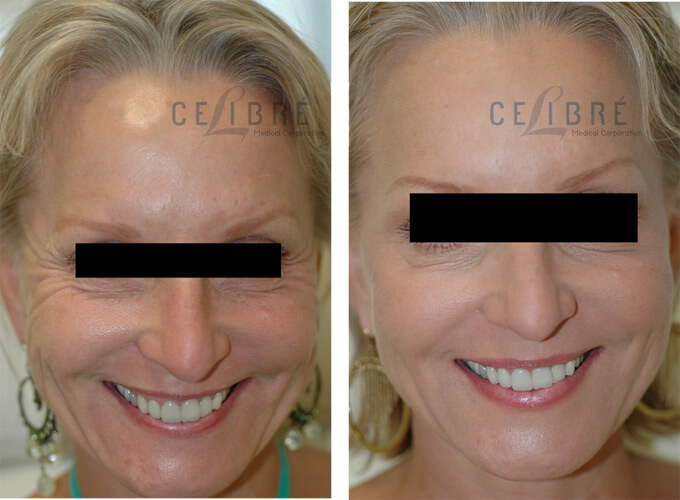
Tired Eyes and Dark Circles (Tear trough):
Finally, the area under the eyes (the tear trough) represents the most difficult area to treat. In this area, for patients without too much excess skin, we normally opt for a dermal filler such as Restylane. Often the issue in this area is hollow eyes or dark circles in addition to fine lines. Restylane can help with all three. And when the skin is a little loose and the texture needs improvement, we reach for the Sciton Profractional for fractional laser resurfacing. See photos below.

You may not recognize the name sebaceous hyperplasia, but you’d might recognize the issue if you saw it. Maybe you even have a few yourself. Many people mistake them for pimples or acne, but they aren’t closely related. Sebaceous hyperplasia consist of small to medium-sized, white or flesh-colored bumps that never go away on their own. They pop up in areas of the face that have the most oil glands: the forehead, nose, inner cheeks and chin.
Most people develop them in their mid to late adult years, and unfortunately, there’s no way to prevent them from happening. They are simply oil glands that have grown too large to remain “hidden” within the skin. They are so large, they become visible to the naked eye.
Luckily, there are a couple effective options for treatment. A hyfrecator (cauterization) is a good, traditional option to help with these lesions. While it’s not perfect, the bumps can remain flat for an extended period of time after treatment.
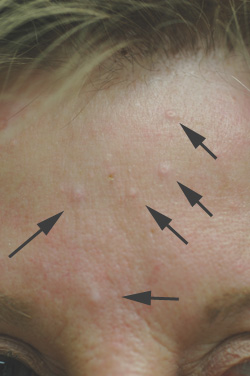
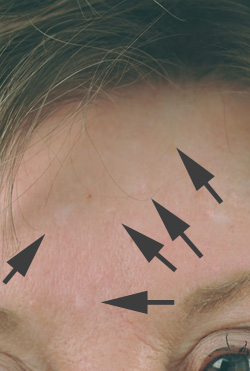 665
665
More recently, the use of light-sensitizing medication and light exposure has become the best, most effective way to get rid of these bumps. You may recognize this process by the name of ALA-PDT. Although it’s not FDA-approved for use on sebaceous hyperplasia, it’s considered both safe and effective. The reason it works is because the medicine (ALA or aminolevulinic acid) is heavily absorbed by your oil glands. When your skin is exposed to light, the energy is directed to the oil glands, damaging them. This usually causes them to shrink and/or go away altogether. So, if you have acne or oilier skin, you will see improvement with these problems too!
ALA-PDT is a treatment that is safe for any skin type (color), so anyone is a candidate for treatment. Here at Celibre Medical, we usually recommend a series of three treatments spaced 2 to 4 weeks apart to effectively clear most of your sebaceous hyperplasia.
Again, it’s important to stress that while it’s not specifically FDA-approved for this use, ALA-PDT is used as treatment for many skin conditions in this way. The body of research is growing on its potential and safety, so we feel confident using it for this tough problem on our patients. It really is the safest and most effective treatment option available today.
There’s no “stretching” the truth that no matter how old you are or whether you’re male or female, if you have stretch marks, you hate them. Maybe you’ve just gone through a pregnancy, gained a bunch of muscle mass or had a rapid change in weight? These scenarios and even general growth during adolescence can be cause stretch marks to appear.
Not everyone’s stretch marks look the same. Some are angry and reddish color. Others are dark or some shade of brown. Finally, some are white or silvery distinctly lighter than the surrounding skin tone. In addition to the range of colors, some stretch marks are flat or flush with the surrounding skin surface while others are more textured, making them look indented or sunk-in.

 No matter what they look like, stretch marks are all caused by a breakdown or tearing in the skin’s connective tissue. Elastic and collagen fibers simply snap under the intense pressure to stretch and cover the body area that is increasing in size. While many people have speculated as to why stretch marks happen for some and not others, we still don’t know. One thing we do know is that they are genetic. If your mom, dad, or someone else in your immediate family has them, chances are that you will too, no matter what preventative steps you take to avoid them.
No matter what they look like, stretch marks are all caused by a breakdown or tearing in the skin’s connective tissue. Elastic and collagen fibers simply snap under the intense pressure to stretch and cover the body area that is increasing in size. While many people have speculated as to why stretch marks happen for some and not others, we still don’t know. One thing we do know is that they are genetic. If your mom, dad, or someone else in your immediate family has them, chances are that you will too, no matter what preventative steps you take to avoid them.
Why would one person in my family have stretch marks and not another?
No one has a direct answer to this question. Just like siblings can have either brown or blue eyes, it all depends on the genes that you inherit. We believe there are certain genetic factors that make some people more disposed to developing stretch marks than others, even someone in your immediate family.
Are my stretch marks permanent?
In most cases, yes as they are a type of scar. However, laser treatments can significantly alter the color improve texture.
Are there any creams or lotions that I can use to prevent or fade my stretch marks?
Not to our knowledge. The creams out there that claim to fade stretch marks often do so with ingredients that “plump” the skin around them. This effect is usually lost once you stop using the cream, so it really isn’t an effective treatment and certainly not a cure. No matter what you do to prevent them, stretch marks will usually happen anyway if you’re genetically predisposed to developing them.
Why do some stretch marks look different than others?
The reasons why people develop stretch marks can differ, but they all share the common thread of the skin’s inability to accommodate a change in size or the inability of the skin to “stretch” to keep up. The reason that you see different colors (red, brown, white) is largely due to a person’s skin type (color) and how long the stretch mark has been there.
New stretch marks on those with lighter skin (Caucasian, etc.) are usually angry and red. Sometimes, these will eventually fade a bit to a lighter shade with time. Sometimes, they are purple in appearance. If your skin is darker, then your stretch marks may be dark brown or some shade of brown. These often don’t fade with time. White stretch marks are usually ones that have been around for quite some time. They are older and much more difficult to treat because they’ve lost most of the pigmentation in the skin.
Which type of laser treats which type of stretch mark?
Usually, both red and brown stretch marks can be treated with lasers. Pulsed dye lasers work well to target the blood vessels that make up the color of red stretch marks, and q-switched lasers target the excess pigmentation, or melanin, that give brown stretch marks their dark color.
White or hypo-pigmented stretch marks are often the toughest to treat because they don’t have an easy target for a laser to see. Also, we don’t yet have a laser that can stimulate these white marks to make more pigment to help them blend in with the surrounding normal skin. With lighter stretch marks, we focus on using lasers to improve the surrounding skin’s texture which actually helps a lighter stretch look less obvious.
Which lasers does Celibre Medical use to treat stretch marks?
Celibre is unique in that we have many different lasers and are able to mix and match to develop the perfect treatment plan for you. Our nurses are the best in the business and know these devices inside and out which helps them tailor your plan and alter it as needed.
We use the Aramis Quantel to stimulate new collagen and remodel what’s already there. This laser works by using heat. This is important when we can’t target a specific color in a stretch mark (red or brown). By building collagen in the skin around it, the stretch mark shrinks a bit and looks less obvious. We use a pulsed dye laserto target the redness and a Q-switched laser to fade brown, hyper-pigmented stretch marks.
In many of our patients, we’ll use a combination of all three of these lasers. If you’re a researcher, then you may have read about other facilities that use fractionated, erbium or plasma lasers with or instead of some of the options listed above. While there’s nothing wrong with this approach, we have found in our experience that we get the same results by skipping these more aggressive, expensive lasers that require recovery time.
What should my expectations be if I have laser treatment of my stretch marks?
In a word: realistic. At Celibre Medical, we won’t promise you results that we know we can’t deliver. Instead, we’ll tell you to expect the minimum amount of improvement, and if we get more (which we usually do), then everyone’s happy! Any facility that promises to completely eliminate or erase stretch marks is trying to sell you something, not take care of you. If it sounds too good to be true, then it usually is.
Are there specific questions that I need to ask during my consultation?
Our general advice is to make sure you understand the how and why of everything that’s being proposed to you. A couple of suggestions would be:
Can any skin type (color) have laser treatment for stretch marks?
Yes! The lasers that we’ve discussed here can all be safely used on any skin type (color). Another bonus is that they are all no downtime treatments which means you can get right back to your life afterwards.
How long do the laser treatments take?
It really depends on how many stretch marks we’re treating. If you have only a few, the laser treatment may last a short 15 to 20 minutes. More extensive stretch marks may require an hour or so to treat.
Is there anyone who is not a candidate for laser treatment of stretch marks?
In our practice, we pride ourselves on our integrity. We won’t treat the following people:
How do I know if a tummy tuck would be a better choice for me?
We don’t pretend to be plastic surgeons. With that said, we can give you an idea if you have enough excess skin or abdominal tissue to qualify as a surgical candidate. We’ll also tell you that if your stretch marks extend up above your belly button, then you can expect that a surgery will not remove them completely. Most of these patients can have only 50% to 60% removed with this type of surgery.
When should I have laser treatment of my stretch marks?
Current research shows that the sooner they are treated, the better your results will be. We believe this is because the laser disrupts some of the continued inflammatory process that happens during the formation of a stretch mark. Halting the process makes it easier to rebuild the skin and reverse the visible effect.
Do you constantly fret about those thin, vertical lines just above your upper lip? They seem to be a lipstick magnet and no matter what lip-plumping agent you try, they make your lips (and mouth) look older than you feel. Although they are commonly referred to as smoker’s lines, smoking is only one of the reasons we get them. For many of us, smoker’s lines occur as part of the normal facial aging process.
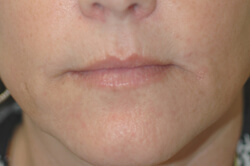
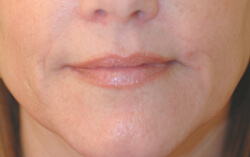
Here’s what happens: smoker’s lines follow the contraction pattern of the strong, purse-string like muscle that encircles the mouth. When we are young, our skin and lips are thick and full of collagen and elastin. They resist wrinkling despite the strong and repeated muscular contractions associated with talking, laughing and eating. As we age though, our skin thins and we lose volume. When this occurs, the muscle starts winning and the lines start showing.
We do have a few weapons we can use to get rid of smoker’s lines. First, we can replace lost volume with hyaluronic acid-based dermal fillers such as Juvederm and Restylane. This treatment helps, but only corrects one of the underlying factors that cause the lines. To complement the dermal fillers, we often weaken the muscle that causes the lines with a small amount of Dysport (Botox). Finally, fractional laser resurfacing is an excellent long term option to remedy smoker’s lines, but does have a week of recovery time. The injection combination of Restylane and Dysport combined with laser resurfacing works best.
We often think of stretch marks as a problem during pregnancy, but if you’re a woman who has gone through puberty, you know that they can happen during that time as well! And it’s not just a problem that affects women. Men can suffer with stretch marks too. They can be embarrassing and limit your clothing choices, making it hard for you to dress to work out or put on a bathing suit.
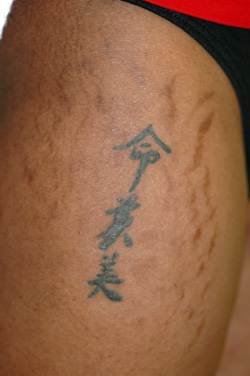
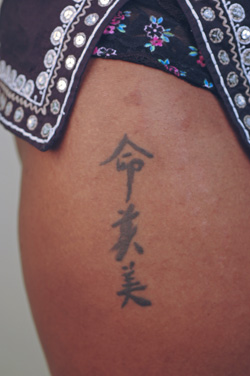 Stretch marks happen when there is a breakdown of elastin in the skin. Elastin is an important component in the middle layer of skin—the dermis—that along with collagen, helps the skin look and feel supple, firm and smooth. When the skin is stretched beyond it’s normal capacity, like with pregnancy, puberty or rapid weight/muscle gain, the production of elastin can’t keep up and a stretch mark forms.
Stretch marks happen when there is a breakdown of elastin in the skin. Elastin is an important component in the middle layer of skin—the dermis—that along with collagen, helps the skin look and feel supple, firm and smooth. When the skin is stretched beyond it’s normal capacity, like with pregnancy, puberty or rapid weight/muscle gain, the production of elastin can’t keep up and a stretch mark forms.
If you have a darker skin type (Hispanic, Asian or African-American), then you probably have dark colored stretch marks. And if you’re wondering if there is a treatment that can help dark stretch marks disappear, there is! It’s a laser treatment that helps to break up the dark pigmentation in the stretch mark, helping it blend into the surrounding skin. The specific laser that is uses is called a q-switched laser. These lasers use different energy sources, but they are all designed to deliver energy in a very powerful, short burst. This “burst” is what makes q-switched lasers different from other types of lasers.
Q-switched laser treatment of dark stretch marks works great, and treatments only take about 30 minutes to complete and are very tolerable. Best of all, q-switched lasers are safe for any skin type and many patients will see fading of dark stretch marks in as little as two to three treatments! There is no downtime after q-switched laser treatment, so you can get right back to your favorite activities, school and work. Here at Celibre Medical, we recommend a series of treatments spaced about a month apart for the best results.
The term “rejuvenate” means to make someone or something look or feel better, younger or more vital. In today’s aesthetic industry, facial rejuvenation refers to the multitude of procedures and treatments that claim to restore youthful facial features. If you’re interested in facial rejuvenation, finding a skilled and knowledgeable provider like the ones at Celibre Medical can help you prioritize what’s most important to you.
Maybe you have facial discoloration (red or brown), or you want to reduce your pore size or tighten your skin? Perhaps you want to reduce the appearance of the lines and wrinkles? Or maybe it’s some old acne scars that are bothering you. Whatever is bothering you, we have an option. We like to refer to the four “R’s” of rejuvenation: Relaxing, Refilling, Resurfacing and Removal. We believe that your specific combination of treatments and/or procedures should focus on these four goals for you to truly achieve facial rejuvenation.

Relaxing
With the help of injections of Botox or Dysport we can soften or even remove your fine lines and wrinkles. Repeated contraction of your facial muscles can trigger unwanted lines and wrinkles at the sides of your eyes, your mouth, forehead or between the eyebrows. These injections relax overactive muscles to restore a smoother, rested appearance.
We also use Botox to relax overactive muscles in your chin and at the corners of your mouth. Though not widely used, these techniques for the lower face can transform and smooth your chin and turn the edges of your mouth upwards helping you look younger and with just the hint of a smile.
Refilling
We use dermal filler injections of products such as Restylane, Restylane Lyft, Juvederm (all hyaluronic acid-based fillers) as well as Radiesse and Sculptra to reshape your facial features and fill in specific fine lines and wrinkles. These products have a much different capability than Botox or Dysport and are not interchangeable.
Dermal fillers are used to redefine your lips, restore lost lip volume, and plump the apples of your cheeks. If you’ve noticed folds forming at the sides of your mouth or chin (marionette lines), these products are an excellent choice to smooth those as well. Lastly, dermal fillers can smooth the transition area between your lower eyelid and upper cheek. This is known as the “tear trough” and filling this area can make you look much less tired and reduce the appearance of small bags and under-eye circles.
Resurfacing
At Celibre Medical, we use laser resurfacing technology to achieve lasting improvements with the texture of the skin. Rather than light peels or microdermabrasions, we utilize our Sciton Profractional laser to improve revive tired and dull outer layers of the skin while stimulating collagen production deep in the skin.
Removal
This “R” focuses on getting rid of the brown and/or red discoloration that appears so commonly as we age. For brown spots, our q-switched laser and Sciton BBL work quickly and effortlessly to remove sun spots, freckles, birthmarks and more. If you have redness, broken capillaries or other red spots on your skin, we have two vascular lasers ready to remedy these conditions.
Facial Rejuvenation is not “one size fits all”
Whatever your particular concern or overall goal is for your facial rejuvenation, we can help you decide which treatments are best for you based on your needs, budget, and lifestyle. At Celibre Medical, we believe in taking an individualized approach to facial rejuvenation that puts you at the center of all that we do.
Acrochordons, fibroepithelial polyps, and papillomas are all fancy names for skin tags. Chances are, you’ve got one (or more) of them somewhere on your body. Skin tags tend to pop up (literally) in your underarms, groin and neck area—usually places that rub a lot. You’ve seen them: little, skin-colored, fleshy bumps that are about 1 to 3 millimeters in size. And no, they aren’t warts or cysts or any other type of infectious…they simply happen to some of us!
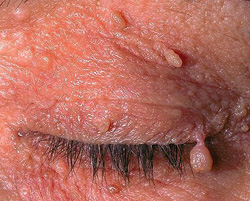 Photo courtesy of Dermnet New Zealand
Photo courtesy of Dermnet New Zealand
The good news is that skin tags are almost always benign (non-cancerous), although we sometimes tend to see them more often in those who are overweight. Skin tags generally don’t require medical treatment. For those of us suffering with them, we can’t get them removed fast enough!
Celibre Medical is a laser dermatology facility. We love lasers and we have lots and lots of them. While there are a lot of conditions that we treat with lasers, removing skin tags is not one of them.
So, how do you get rid of skin tags? They are best removed using a hyfrecator. Electrodessication is a treatment where the tag is heated to a high temperature with a very fine probe or needle. Although a little uncomfortable, the reward for getting them removed is sweet.

